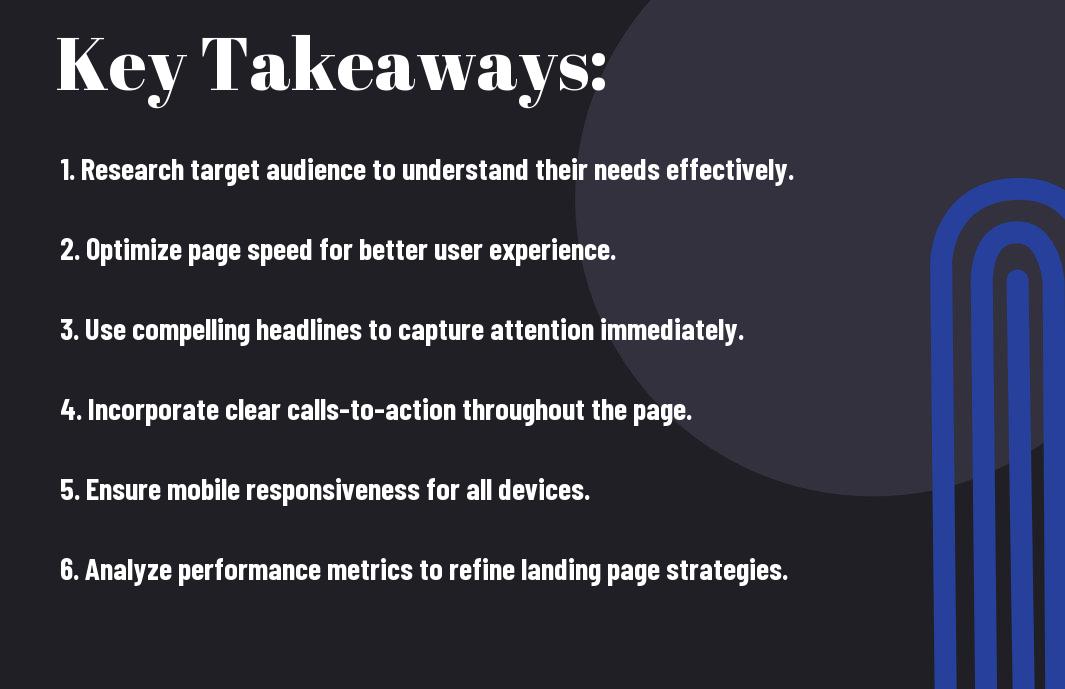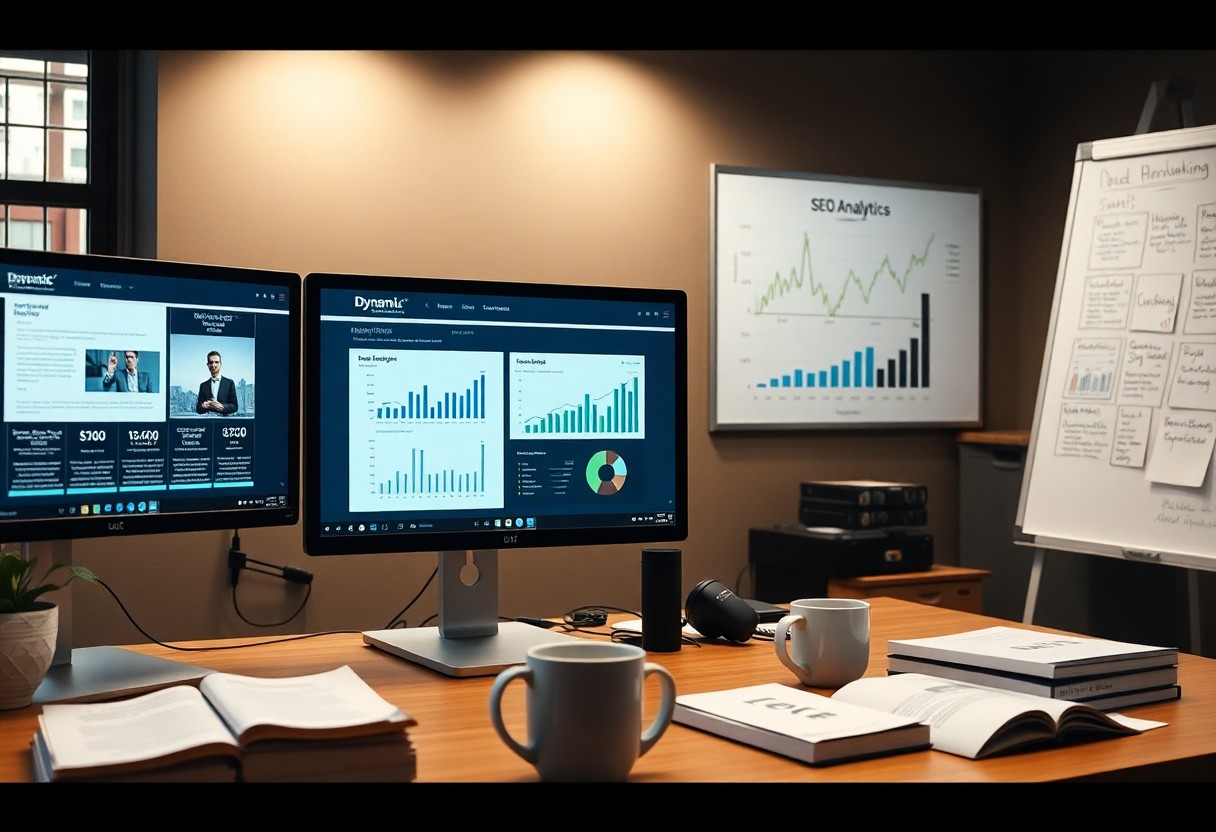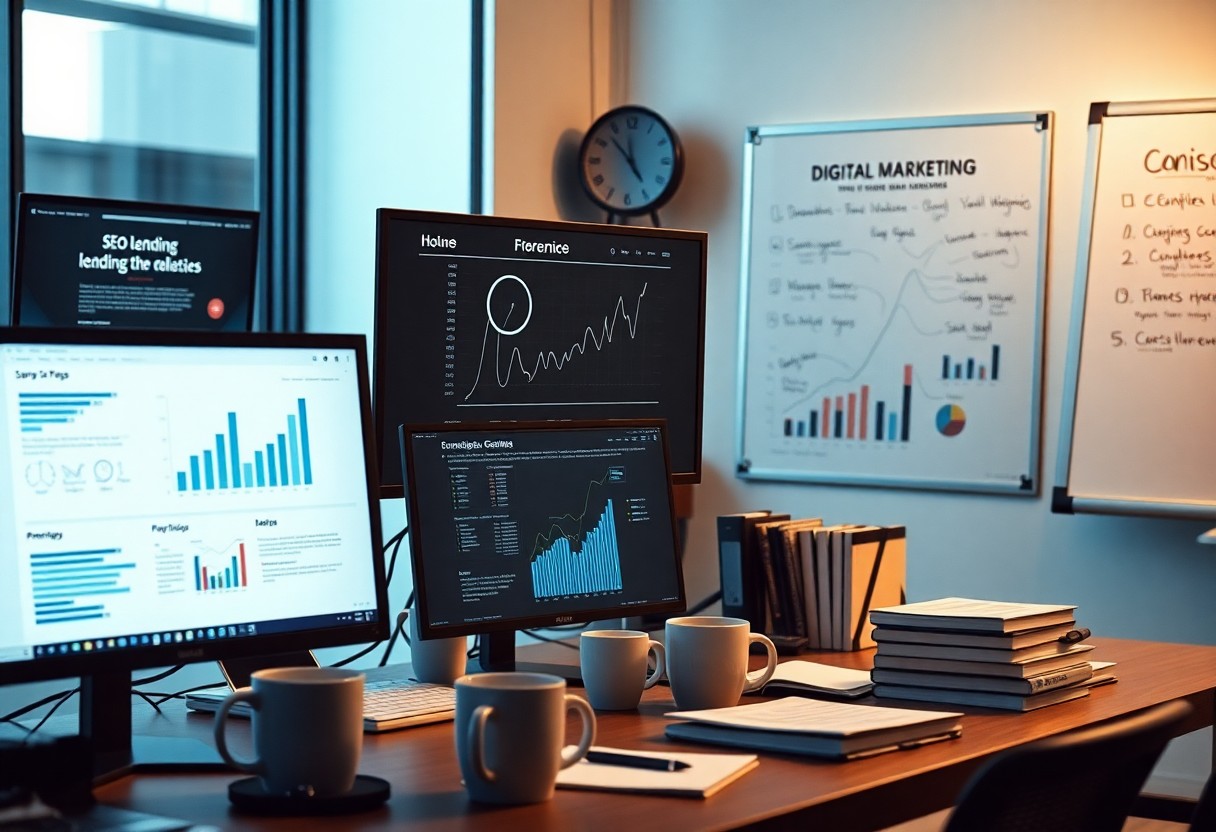There’s a growing need for SEO agencies to understand the important steps needed to develop dynamic landing pages that effectively convert visitors into customers. By focusing on aspects like target audience analysis, compelling content, and optimized user experience, they can enhance their pages’ performance. Furthermore, implementing best SEO practices is vital in driving organic traffic to these landing pages. Through strategic planning and execution, an SEO agency can significantly boost conversion rates and achieve remarkable results for their clients.
Key Takeaways:
- Focus on creating compelling and clear headlines that immediately convey the value proposition to visitors.
- Utilize engaging visuals and multimedia elements to enhance user experience and maintain interest.
- Incorporate strong calls-to-action (CTAs) that guide users toward desired actions, ensuring they stand out on the page.
- Optimize landing page load speeds and mobile responsiveness to accommodate diverse audience devices, improving overall retention.
- Leverage data analytics to continually test and refine landing page elements based on user behavior and conversion rates.
Understanding Landing Pages
Definition of Landing Pages
The concept of landing pages is pivotal in digital marketing. With a landing page, she means a standalone web page designed specifically for a marketing or advertising campaign. Its primary goal is to convert visitors into leads or customers, guiding them toward a specific action, which might include signing up for a newsletter, making a purchase, or filling out a contact form. By focusing on a single objective, landing pages minimize distractions and increase the likelihood of conversion.
With an eye-catching design and compelling content, landing pages serve as the first point of interaction for potential customers. They are tailored to address the needs of the target audience, utilizing persuasive copy and relevant visuals to draw users in and encourage them to take action. This makes understanding landing pages key for any SEO agency looking to maximize their clients’ online presence.
Importance of Landing Pages for SEO
Below are several reasons why landing pages play a significant role in SEO. They contribute to a site’s overall visibility on search engines and directly affect ranking. By optimizing landing pages with targeted keywords and high-quality content, he can enhance their performance in search results, resulting in more organic traffic. Furthermore, a well-designed landing page can significantly reduce bounce rates, signaling to search engines that the site provides valuable content, which further boosts its ranking potential.
Landing pages, when strategically crafted and optimized, can serve as high-value assets in an SEO strategy. Implementing relevant meta tags, alt text, and internal linking through landing pages can improve a site’s structure and relevance. He should take time to analyze user behavior on these pages to make data-driven adjustments that improve conversion rates and overall effectiveness.
Types of Landing Pages
After understanding the basic premise of landing pages, they can be classified into different types based on their objectives and design. Common types of landing pages include:
| Lead Generation Pages | These landing pages are designed to capture visitor information through forms. |
| Click-Through Pages | Typically employed to warm up prospects before a sale, these pages invite users to click through to another location. |
| Squeeze Pages | Focused on obtaining email addresses, these pages offer something in return. |
| Sales Pages | Designed to make a direct sale, these pages highlight product benefits and persuade users to make a purchase. |
| Thank You Pages | These pages appear after an action is completed, such as signing up or purchasing. |
Landing pages serve specific functions in a marketing strategy, and comprehending the differences is necessary. Each type can be optimized for conversion and tailored to specific campaign needs. Perceiving the advantages of each type enables marketers to allocate resources effectively and target their messages appropriately for maximum impact.
Landing pages also thrive on user experience. By assessing metrics such as conversion rates and engagement, SEO professionals can refine their strategies to make these pages even more effective. Analyzing traffic sources and conducting A/B testing are further steps to enhance performance. Ultimately, understanding the types of landing pages allows he to build a more structured and goal-oriented approach, benefiting their clients greatly.
- Lead Generation Pages
- Click-Through Pages
- Squeeze Pages
- Sales Pages
- Thank You Pages
Through a solid understanding of various landing page types, she can master the art of digital persuasion. Strong, user-focused landing pages are necessary for conversion, and with the right framework, they can yield impressive results in any online marketing strategy.

Key Elements of a High-Converting Landing Page
It is imperative for an SEO agency to focus on the key elements that contribute to the effectiveness of landing pages. Each element must be carefully crafted to ensure that they work together seamlessly to convert visitors into customers. A well-structured landing page will address the needs and expectations of potential clients, ultimately guiding them toward a desired action.
Compelling Headlines
Above all, a landing page must feature compelling headlines that immediately capture the attention of the audience. The headline serves as the first interaction a visitor has with the content, and it must convey the primary value proposition succinctly. A punchy and relatable headline can spark curiosity and encourage further exploration of the page.
Additionally, the headlines should be tailored to resonate with specific target audiences, often leveraging pain points or desires to establish a connection. He or she should ensure that the headline is not merely attention-grabbing but also relevant to the content that follows, fostering trust and credibility.
Engaging Visuals and Media
Headlines alone create an impression, but engaging visuals and media significantly enhance the overall user experience. High-quality images, videos, and infographics can help convey complex information in an easily digestible format. The inclusion of media reduces cognitive load, allowing visitors to grasp imperative concepts quickly.
Considering the trends in digital consumption, incorporating dynamic elements such as videos or interactive graphics can lead to heightened engagement levels. These visuals should complement the text, reinforcing the primary message and encouraging visitors to stay on the page longer, thereby increasing chances of conversion.
Clear Calls-to-Action (CTAs)
CTAs play a pivotal role in guiding visitors towards taking measurable actions. A clear call-to-action (CTA) must be prominently positioned and designed to stand out on the page. It should be phrased in a way that communicates a sense of urgency or value, triggering an emotional response that moves users to click.
Indeed, the effectiveness of a CTA can be significantly amplified by using contrasting colors and concise language that clearly outlines the benefits of the action. He or she may consider A/B testing different variations to determine which CTAs yield the highest conversion rates, ensuring that the most effective version is implemented across the site.
User-Friendly Design and Layout
Landing pages should prioritize a user-friendly design and layout. An uncluttered and organized structure allows visitors to navigate the content intuitively, minimizing frustration. Simple and clear navigation ensures that visitors can find the information they need without excessive effort, leading to an increased likelihood of conversion.
In fact, using a grid layout for content can help maintain visual order, while ensuring the most critical information is readily visible. Simplifying forms and utilizing white space effectively can also play a significant role in enhancing the user experience, as visitors are more likely to engage with content that feels approachable and easy to digest.
Trust Signals and Testimonials
Around the edges of successful landing pages, trust signals and testimonials are strategically placed to foster credibility. Trust signals, such as security badges, industry certifications, or loyalty guarantees, can reassure visitors that their sensitive information is safe. Meanwhile, testimonials from satisfied customers serve as social proof, encouraging potential leads to consider the service with confidence.
Trust cannot be understated in online conversions. He or she should creatively integrate testimonials—whether through written quotes, star ratings, or video endorsements—because such elements can significantly influence a visitor’s decision-making process, ultimately swaying them to commit to a conversion.

SEO Best Practices for Landing Pages
Now, when creating landing pages that convert, it is vital for an SEO agency to implement best practices that ensure both search engine visibility and user engagement. One of the first steps in this process involves effective keyword research and integration, enabling the agency to target the right audience and align their content with what potential customers are searching for.
Keyword Research and Integration
Landing page optimization starts with thorough keyword research. By identifying relevant keywords and phrases that the target audience searches for, an SEO agency can tailor the content to potential customer needs. They must ensure that these keywords fit naturally within the content, guiding users through the page while enhancing its relevance to search engines.
She should also monitor keyword performance over time, allowing for adjustments based on changing user behavior and search trends. An effective strategy may involve using variations and long-tail keywords to capture a wider audience and disguise the landing page’s relevance across diverse search queries.
Meta Tags and Descriptions
At the same time, optimizing meta tags and descriptions is vital to attract clicks from search results. The title tag and meta description serve as the first impression of a landing page, conveying its value to users quickly. They should include targeted keywords that reflect the content while enticing prospective customers with clear, compelling language.
He must ensure that the meta tags are not too lengthy, as search engines may truncate longer versions, causing critical information to be lost. Including a call to action in the meta description can also drive higher click-through rates, leading to increased traffic on the landing page.
It is important to note that effective meta tags and descriptions can significantly impact the landing page’s visibility and performance. The conversion rate often correlates with how well these elements communicate the page’s purpose and engage potential visitors, leading to improved SEO performance.
Image Optimization
To enhance a landing page’s performance, the use of image optimization cannot be overlooked. Optimizing images not only improves the user experience by reducing load times but also allows for better indexing by search engines. This involves using relevant file names, alt tags with targeted keywords, and ensuring images are compressed for quick loading without sacrificing quality.
By leveraging image optimization techniques, an SEO agency can create visually appealing landing pages that also adhere to best practice guidelines, thereby increasing the likelihood of conversions. Moreover, visually rich pages are more engaging, which can enhance user dwell time and further signals quality to search engines.
Keyword optimization plays a substantial role in image-related elements, as well. An agency should routinely review image-related SEO metrics to gauge their impact on landing page performance and adjust their strategies accordingly to improve visibility.
Mobile Optimization
Behind every successful landing page lies mobile optimization. With the rising number of users accessing websites via smartphones, it is critical that an SEO agency tailor landing pages for mobile devices. This involves adopting responsive design practices, ensuring text is readable, buttons are accessible, and navigation is intuitive.
Adjusting content to fit smaller screens not only enhances user experience but is also favored by search engines, which prioritize mobile-friendly designs in their ranking algorithms. An optimized mobile landing page can lead to lower bounce rates and higher conversion rates due to improved accessibility and usability.
In addition, mobile optimization also includes minimizing the number of redirects and ensuring that all interactive elements function seamlessly on mobile devices. This comprehensive approach can significantly elevate the user experience and enhance the landing page’s overall efficacy.
Page Load Speed
Landing page speed is another pivotal factor that can influence both SEO rankings and user experience. Websites that load slowly can frustrate users, leading them to abandon the page before fully engaging with the content. An SEO agency should aim to minimize loading times by compressing images, leveraging browser caching, and utilizing content delivery networks (CDNs).
Additionally, monitoring page load speed through tools can help identify specific points of failure. By addressing these areas effectively, they can enhance the site’s speed, leading to more engaged users and improved search engine rankings.
Meta tags and related elements also play a part in performance metrics. A well-formatted landing page with optimized images and clear messaging will often result in higher user satisfaction, translating to better page load speed and a greater likelihood of keeping users on the site.
Dynamic Content Strategies
For an SEO agency, employing dynamic content strategies can significantly enhance the effectiveness of landing pages. These strategies enable personalized user experiences tailored to individual visitor interests and behaviors. Incorporating dynamic content can lead to increased engagement and conversion rates by presenting information that resonates with the target audience. For inspiration, they might explore 8 dynamic landing page examples and best practices that showcase successful implementations of these strategies.
Personalization Techniques
Below are various personalization techniques that can be employed to make landing pages more engaging. By analyzing user data, agencies can modify language, images, and offers to create a customized experience that speaks directly to individual preferences. Techniques such as geolocation can modify content based on the user’s location, displaying relevant offers or relevant visuals that resonate more with the potential customers.
They can also consider utilizing retargeting techniques where visitors who abandon their carts are presented with tailored messages or incentives when they return. This level of personalization encourages users to engage with the content, increasing the likelihood of conversion.
A/B Testing for Content Variation
The implementation of A/B testing is vital for optimizing dynamic content on landing pages. By comparing two versions of a webpage, agencies can determine which variations resonate better with visitors. This method enables them to analyze different elements such as headlines, calls-to-action, and images, refining their approach based on measurable outcomes.
Considering the data generated from A/B testing allows SEO agencies to make informed decisions about content adjustments. This ongoing analysis leads to continuous improvements and, ultimately, higher conversion rates. Without testing different variations, agencies may miss opportunities to enhance user engagement.
Incorporating Real-Time Data
Against a backdrop of fast-paced digital experiences, incorporating real-time data into landing pages can provide visitors with current and relevant information that enhances their journey. For example, displaying live updates on inventory, pricing changes, or even user testimonials can create a sense of urgency and relevance that spurs action from potential customers.
Hence, utilizing real-time data empowers SEO agencies to create dynamic landing pages that feel alive and responsive to visitors. Integrating APIs that deliver up-to-the-minute statistics or engaging content can significantly boost user interaction and trust in the brand. When visitors feel they are receiving relevant, current information, they are more likely to engage with the page and convert into customers.
Analytics and Performance Tracking
All SEO agencies must prioritize analytics and performance tracking to ensure their dynamic landing pages are effective and converting. He should leverage insights from performance data to refine strategies and enhance user experience. By analyzing these metrics, she can identify what works and what needs improvement. A solid understanding of how to track and interpret analytics allows agencies to make data-driven decisions, paving the way for better outcomes. For more insights, explore the Dynamic Landing Page Best Practices.
Key Metrics to Monitor
Across the digital landscape, there are several key metrics that he should focus on to gauge the effectiveness of landing pages. Metrics such as conversion rate, bounce rate, and average time on page provide valuable insights into user engagement. She must particularly pay attention to the conversion rate, as it directly reflects the percentage of visitors who take the desired action on the landing page. Any significant fluctuations in these metrics can indicate areas that require immediate attention and adjustment.
He should also track click-through rate (CTR), as it illustrates how well the landing page captures attention and encourages users to click. Monitoring exit rates can help his agency understand where visitors lose interest and leave the page without converting. These evaluations can guide her in continuously optimizing landing page elements to create a more compelling user journey.
Tools for Tracking Landing Page Performance
Around analytics, there are numerous tools available to assist in tracking landing page performance effectively. Popular tools like Google Analytics, Hotjar, and SEMrush offer comprehensive features for measuring key metrics. These platforms provide dashboards that visualize data, allowing him to easily spot trends and anomalies that may impact conversion rates.
Tracking these metrics using automated tools can lead to insights that are otherwise difficult to discern manually. By leveraging the power of these analytics tools, SEO agencies can streamline the data analysis process, ensuring teams always have access to the latest performance metrics. Ultimately, this will help them respond quickly and adapt strategies based on real-time data.
Analyzing User Behavior
Landing page performance is heavily influenced by user behavior, making it a vital area he should scrutinize. Understanding how users navigate through a landing page and what elements capture their attention allows them to optimize content and design for better engagement. He should utilize heat maps and session recordings to visualize user interactions and identify any points of friction that lead to high bounce rates.
In addition, conducting A/B testing can help his agency determine the most effective variations of landing page elements. By comparing the performance of different headlines, calls to action, and layouts, they can make informed adjustments that resonate with the target audience. This methodology can significantly enhance the overall effectiveness of landing pages in driving conversions.

Case Studies and Real-World Examples
Once again, examining real-world examples of successful and failed SEO landing page campaigns can provide invaluable insights. Learning from these case studies allows an agency to understand what tactics effectively convert visitors into customers. Here are several examples that showcase the impact of optimizing landing pages for improved conversion rates:
- Company A improved their conversion rate by 200% after implementing A/B testing on their landing pages. They specifically focused on headline changes and visual elements that guided user behavior.
- Company B saw a 150% increase in sign-ups after integrating testimonials and trust signals, showcasing the influence of social proof on user decision-making.
- Company C achieved a drop in bounce rate from 60% to 25% by refining their call-to-action buttons and making them more prominent on their landing pages.
- Company D boosted sales by 300% through personalized landing pages that targeted specific audience segments with tailored offers based on user behavior.
- Company E realized a 120% uplift in conversion rates by employing video content on their landing pages, appealing to the growing trend of engaging multimedia.
Successful Landing Page Campaigns
The examination of successful landing page campaigns reveals that well-designed pages can substantially increase conversion rates. For instance, a recent case study shows that Company F focused on minimalist design and clear messaging, resulting in a 250% boost in conversions over their previous layout. They leveraged analytics to pinpoint elements that resonated with their audience and removed distractions that previously hindered user engagement.
Furthermore, Company G’s use of targeted landing pages for different marketing channels led to a remarkable 175% increase in lead generation. By aligning specific landing pages with various ads, they ensured that users had a seamless transition from their ad engagement to the action they intended to take, thus maximizing the potential for conversion.
Lessons Learned from Failed Campaigns
Examples of failed landing page campaigns provide equally important lessons about what not to do. Company H launched a campaign that featured a cluttered page with multiple call-to-action buttons, resulting in scattered user focus and a dismal 10% conversion rate. Such outcomes illustrate the dangers of overcomplicating a landing page, diminishing the likelihood that visitors will complete the desired action.
Another notable failure occurred with Company I, which neglected to optimize their mobile experience. With 85% of their traffic coming from mobile devices, their desktop-only landing page suffered an alarming 75% bounce rate, leaving them with minimal leads. This situation emphasizes the significance of ensuring that landing pages are not only desktop-friendly but also optimized for mobile users.
But, analyzing these failures reveals the potential for improvement. Each misstep has provided valuable data that informs better practices. For instance, Company H revised their approach by simplifying design elements and focusing solely on one call to action, which ultimately led to a significant recovery in performance.
Industry-Specific Landing Page Strategies
Around various industries, tailoring landing page strategies to specific user needs can unfold significant opportunities for conversion. In the e-commerce sector, for instance, using high-quality visuals and customer testimonials on product landing pages can enhance trust and encourage purchases. Meanwhile, in the B2B sector, offering comprehensive case studies and detailed service descriptions can alleviate doubts and move prospects down the sales funnel.
Additional findings suggest that businesses can leverage industry-specific keywords and language to resonate more deeply with their target audiences, thus increasing engagement. Crafting landing pages that reflect the unique values and pain points of potential clients can serve as a powerful differentiator in competitive markets.
To maximize the effectiveness of industry-specific strategies, agencies should conduct extensive market research to identify the most impactful messaging and offerings related to their clients’ sectors. Focusing on these tailored approaches can position them to create landing pages that not only attract but also convert visitors into loyal customers.
Summing up
Now, an SEO agency must focus on several critical elements to create dynamic landing pages that effectively convert visitors into customers. They should emphasize the importance of understanding the target audience, ensuring that every aspect of the landing page speaks directly to potential clients’ needs and preferences. He or she should also ensure that the design is visually appealing and user-friendly, facilitating easy navigation and engagement. Testing variations of elements such as headlines, calls-to-action, and visuals through A/B testing can further help them identify which combinations result in the highest conversion rates.
In addition, optimizing landing pages for mobile devices is crucial, as a significant percentage of users interact with content via smartphones. By prioritizing speed, responsiveness, and relevant content, they increase the likelihood of retaining visitors. Furthermore, utilizing analytics tools enables them to measure performance and gather insights that inform continuous improvements. By following these crucial steps, an SEO agency will be well-equipped to create landing pages that captivate visitors and drive conversions effectively.
FAQ
Q: What are dynamic landing pages?
A: Dynamic landing pages are web pages that automatically change content and layout based on visitor behavior, preferences, or other data inputs. These pages use technologies such as JavaScript and server-side scripting to tailor the user experience, ensuring that visitors find relevant information that increases the likelihood of conversion.
Q: How can SEO agencies optimize dynamic landing pages for search engines?
A: To optimize dynamic landing pages for search engines, SEO agencies should focus on several strategies. These include ensuring that the page has a clean URL structure, utilizing relevant keywords in the title tags and meta descriptions, employing structured data markup to enhance visibility in search results, and creating unique content for each version of the landing page to avoid duplication issues. Additionally, agencies should ensure that page load times are fast and that the design is mobile-friendly.
Q: What role does A/B testing play in enhancing dynamic landing pages?
A: A/B testing is instrumental in improving dynamic landing pages by allowing agencies to compare different versions of a page to determine which one drives higher conversion rates. By testing various elements such as headlines, call-to-action buttons, and images, agencies can gather data on user preferences and behaviors. This data can then be analyzed to refine the landing page further and optimize it for better performance.
Q: How should content be personalized on dynamic landing pages?
A: Personalized content on dynamic landing pages can be achieved by using data analytics to gather insights about user profiles, behaviors, and demographics. Agencies can implement strategies such as displaying location-specific information, recommending products based on previous purchases, or adjusting messaging to resonate with the target audience’s interests. This tailored approach increases relevance and engagement, ultimately leading to higher conversion rates.
Q: What metrics should be tracked to evaluate the effectiveness of dynamic landing pages?
A: To assess the effectiveness of dynamic landing pages, agencies should track several key metrics, including conversion rate (the percentage of visitors who complete a desired action), bounce rate (the percentage of visitors who leave without interacting), average time on page (to gauge engagement), and click-through rate (for specific calls to action). Additionally, analyzing user behavior through heatmaps and session recordings can provide insight into how users interact with the landing page, revealing opportunities for further optimization.


